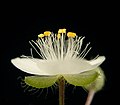Tradescantia fluminensis
| Tradescantia fluminensis | |
|---|---|

| |
| Tradescantia fluminensis | |
| Scientific classification | |
| Kingdom: | |
| (unranked): | |
| (unranked): | |
| (unranked): | |
| Order: | |
| Family: | |
| Genus: | |
| Species: | T. fluminensis
|
| Binomial name | |
| Tradescantia fluminensis Vell.
| |
| Synonyms | |
|
Tradescantia albiflora | |
Tradescantia fluminensis is a species of spiderwort native to South America more commonly known as Wandering Jew, a name it shares with closely related species T. pallida and T. zebrina.
Though often grown in the United States as a garden plant or houseplant, in many places T. fluminensis is considered an invasive species, noxious weed, or pest plant and is consequently targeted for eradication. Seriously affected areas include the southeastern United States[1], Australia,[2] and New Zealand[3].
The seriously invasive qualities of T. fluminensis result from a combination of attributes. Forming a dense mat underneath forest tree cover (facilitated by a remarkable shade tolerance), it smothers ground-level plants and prevents the natural regeneration of taller species; if left unchecked, it can lead to the destruction of native forests. Even where the climate does not permit T. fluminensis to take root, it still can spread rapidly from being transported by animals and humans. The succulent stems break easily at the nodes and establish themselves wherever they land on moist soil. While T. fluminensis does respond to herbicides and other applied weed controls, each segment has the ability to regenerate, so it is able to make a rapid comeback, especially in soft soils where stems may remain underneath the surface. Constant deployment of weed-control agents may have a negative effect upon the local environment, so the only option remaining is manual clearance. This is not necessarily as arduous as it may seem, since an initial clearance performed by simply raking the area will have a significant impact. With repeated efforts, each at intervals of a couple months, complete eradication is possible. Regular monitoring of invasion from neighbouring areas is indicated.
Images
-
comprehensive infestation of Tradescantia fluminensis, covering the forest floor at Chatswood West, Australia
External links
- Standard Data Report: Tradescantia fluminensis - Integrated Taxonomic Information System
- PLANTS Profile: Tradescantia fluminensis - National Resources Conservation Service (US Department of Agriculture)
- Taxonomy Browser: Tradescantia fluminensis - National Center for Biotechnology Information (US National Institutes of Health)
- Desert Tropicals - Informational database on common gardening plants, based out of Phoenix, Arizona, USA
- Dave's Garden - Community website for home gardeners providing supplies, techniques, and discussion forums.
References
- ^ Florida Exotic Plant Pest Council (2007). "Florida Exotic Pest Plant Council's 2007 List of Invasive Plant Species". Retrieved 2008-07-14.
- ^ Wolff, Mark A. (1999). Winning the war of Weeds: The Essential Gardener's Guide to Weed Identification and Control. Kenthurst, NSW: Kangaroo Press. p. 57. ISBN 0-86417-993-6.
- ^ MAF biosecurity New Zealand (2009). "MAF pest report on Wandering Willy". Retrieved 2009-02-07.




